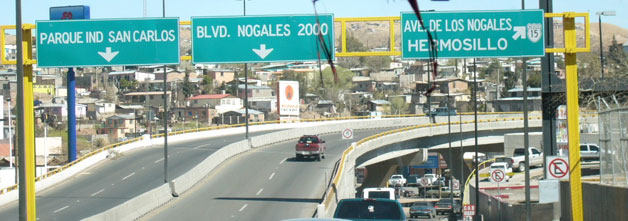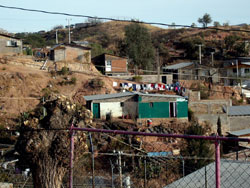|
|
|
Our Trip to Nogales
The fieldtrip we made to Nogales was a trip I have recommended to everyone I have told about it. It wasn’t anything new that I learned that made me so grateful for having the chance to take this trip- it was seeing firsthand what I have learned about Mexico from this class and others. It made the topics I have studied into real people, real circumstances. The immediate change from the US side of Nogales to the Mexican side was astonishing. For one town to have two incredibly different sides of privilege is not something that seems possible. As you drive from the US side you see a typical American small-town: modest homes, worn roads, various fast food restaurants, etc. But upon crossing that border, you step into another world. The buildings aren’t kept up like those in America- in fact, some of the only buildings that look kept up are American: the McDonalds, the Blockbuster Video. These buildings don’t look as sturdy, but they look cheery with coats of paint in every bright shade. Within one block of being across the border I counted three pharmacias, Mexican pharmacies notorious for selling Americans medication without a prescription. In Rick Ufford-Chase’s article Glimpsing the Future: Why Christians Must Resist the Global Economy, he notes the roads, “Many city streets are narrow, rutted dirt paths winding up the sides of the hills.” As I saw first hand, many roads are paved, many more are dirt, with large holes and strewn trash everywhere. The numerous stray dogs navigate surprisingly well through traffic- I stopped being worried for their safety, but wondered how they found food, since many of the human residents barely make ends meet. This world seems chaotic, not orderly like the US. But the American half of the town is almost always within view, accentuating the stark contrast. Ufford-Chase talks about the border wall, “as it climbs the hills that surrounds Ambos Nogales and then trails off into the desert, the wall that divides this city becomes a five-strand, barbed-wire fence.” On the wall are spray-painted tags and messages, “Scared Yankees” is one I remember. Across that wall is a visual reminder of the stark differences between this world and another, easier one.
Yet the other side is not off-limits to border residents. I learned that people living on the border can apply for a border visa, which allows them to travel back and forth with greater ease. Wondering why inhabitants living on the Mexican side of Nogales would go the US side (besides family), I learned that many go to buy groceries and other goods. They are actually cheaper (and apparently better quality) on the US side! Ufford-Chase highlights this irony, “for example, one block South of the port of entry in Nogales, Sonora, old school buses regularly fill with shoppers lucky enough to have documents to cross legally into the United States. These buses, their sides emblazoned with advertisements, are headed for the Safeway, Wal-Mart, and K-mart in Nogales, Arizona…(to buy) goods which were made by Mexicans for less than a living wage in Mexico” (Ufford-Chase). Where Mexicans once used to farm their land and eat and sell their crops, they can no longer afford to do so. In Steve Suppan’s article NAFTA’s Impact on Mexican Agriculture and Rural Life he prophetically writes, “Of the 25 million people who depend on farming for a livelihood, it has been estimated that between 600,000 and 10 million will leave farming during the 10-15 year NAFTA provision phase-in period.” This proved to be true, and caused a great wave of migration to the North, to America when lucky. For those still living on the Mexican side of Nogales, making a trip to the US for food and other supplies wasn’t unusual, as I learned from a Mexican women we shared lunch with. This trip was invaluable to let me see what drives people to migrate. I knew the answers before, but seeing the poverty and understanding how difficult it is to feed oneself really cemented my understanding. |
|


